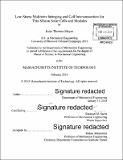| dc.contributor.advisor | Emanuel M. Sachs. | en_US |
| dc.contributor.author | Meyer, Luke Thomas | en_US |
| dc.contributor.other | Massachusetts Institute of Technology. Department of Mechanical Engineering. | en_US |
| dc.date.accessioned | 2018-05-23T16:28:44Z | |
| dc.date.available | 2018-05-23T16:28:44Z | |
| dc.date.copyright | 2018 | en_US |
| dc.date.issued | 2018 | en_US |
| dc.identifier.uri | http://hdl.handle.net/1721.1/115651 | |
| dc.description | Thesis: S.M., Massachusetts Institute of Technology, Department of Mechanical Engineering, 2018. | en_US |
| dc.description | Cataloged from PDF version of thesis. | en_US |
| dc.description | Includes bibliographical references (page 55). | en_US |
| dc.description.abstract | In the field of silicon solar cells and modules, multiwire interconnection technologies have received significant attention due to their performance advantages over conventional buswires. Realization of these benefits has been limited due to additional complex manufacturing steps to create an "S"-style cell interconnection wherein wires are snaked between positive and negative contact areas. It is proposed that by introducing a new method of cell interconnection, multiwire interconnection will become suitable for any thickness of silicon solar cells, including thin (50 [mu]m to 100 [mu]m) cells. In this thesis, a novel multiwire interconnection technique is proposed, wherein two discrete sets of wires are used: one set for the top of the cells and one for the bottom, thereby avoiding the top-to-bottom snaking of wires seen in an "S"-style cell interconnection. The two sets of wires are connected by a cross-connect wire at each cell interconnection, followed by precise removal of small sections of wire to create the series interconnect. A major benefit of the cross-connect wire is its ability to deform during thermal cycling of the module. The discrete sets of multiwire allow the top and bottom wires to be offset, so changes in cell spacing redirect displacements into the cross-connect wire instead of the cell. In this contribution, theoretical simplification of the cross-connect into beam bending components is validated by finite element analysis models. Experimental fatigue tests show the interconnect routinely lasting over 50,000 cycles of ± 100 [mu]m cell gap change, corresponding to over 100 years of field use. Another aspect of this work is developing the ability to manufacture the proposed interconnect. Removal of small portions of the discrete sets of wire is a challenging step, for which a cutting tool was developed. The cutting tool is composed of a set of cutting blades and linear actuators which control the movement of the blades. The cutting blades consist of two rigid outer blades, housing a slot for the thin center blade to slide up and down. After hooking wire into the center blade, actuating the blade upward cleanly and reliably removes a 0.25 mm section of wire. | en_US |
| dc.description.statementofresponsibility | by Luke Thomas Meyer. | en_US |
| dc.format.extent | 65 pages | en_US |
| dc.language.iso | eng | en_US |
| dc.publisher | Massachusetts Institute of Technology | en_US |
| dc.rights | MIT theses are protected by copyright. They may be viewed, downloaded, or printed from this source but further reproduction or distribution in any format is prohibited without written permission. | en_US |
| dc.rights.uri | http://dspace.mit.edu/handle/1721.1/7582 | en_US |
| dc.subject | Mechanical Engineering. | en_US |
| dc.title | Low-stress multiwire stringing and cell interconnection for thin silicon solar cells and modules | en_US |
| dc.type | Thesis | en_US |
| dc.description.degree | S.M. | en_US |
| dc.contributor.department | Massachusetts Institute of Technology. Department of Mechanical Engineering | |
| dc.identifier.oclc | 1036985315 | en_US |
